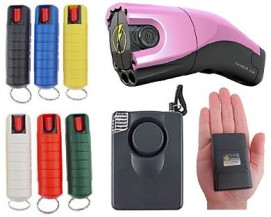
In almost three decades of teaching personal safety and defense, I have seen devices come and devices go related to personal safety. The list is pretty extensive including mainstay items such as pepper spray, TASERS, stun guns, and firearms. Some others I have seen include whistles, body alarms, GPS tracking devices for kids’ clothing or accessories, and more recently smartphone apps to call for immediate assistance in the case of an emergency or attack.
Additionally these devices range in prices. Some may be as little as $10, others hundreds of dollars. Still others are subscription-based devices where you continue to pay. There is truly a lot to choose from in this market, and I really remain neutral on most of these, but wish to offer some thoughts regarding several that many would not necessarily be aware of or even think of when choosing these for their “back-up” in self-defense, if not their primary response in self-defense.
Propellants such as mace or pepper spray are a non-lethal option for many women especially, but I do know of men who use them as well (beyond male police officers, of course). They can even be a potential deterrent for stray dogs that may threaten you or your own dog when walking. But they do have a shelf-life depending upon the canister size chosen, so be aware if you’ve had that same can attached to your key chain for the past several years. Some have even substituted “wasp spray” due to its range and (supposed) accuracy. But when your in a high-stress situation, fine-tune muscle skills like “aim” go out the window anyway. But these are an option.
Electronic weapons such as stun guns and TASERS are yet another option, but do understand the difference. Stun guns are for close-range attacks as you must make physical contact with your attacker to use them, and the results are not always immediate. You may have to continually maintain close contact before the effects truly kick in or take the attacker down. But they do continually “reset” for use again and again if multiple attackers threaten. TASERS, on the other hand are preferred by those who wish to keep their attacker at a safe distance (often used by police officers for this reason). However, they can only be used “once” on a single attacker, and will be quite ineffective in the advent of multiple attackers. And if you “miss” on the initial discharge of the prongs that shoot out, they do not return to strike again like fangs of a snake. Point being, be SURE before you fire!
I have also seen the rise and fall in popularity of noise-makers such as whistles and body alarms. During some research I and my mentor conducted in one state prison system years ago with 1,200 convicted rapists, I have a little different mindset towards these than most. Many of the attackers we spoke to had no fear of a whistle as they could (due to element of surprise) keep the victim from putting it to her mouth prior to the attack. They had more respect for the body alarms which made noise, and often could not be silenced, therefore drawing unwanted attention to their attack. Light and noise are typically two of your greatest allies in preventing attack. These alarms are also used for safety by rock climbers, campers, joggers, etc as injury and location can work against them in a similar fashion.
Firearms are probably the most common device I am asked about in presentations. Again, I am neutral regarding purchase or ownership as their effectiveness is solely dependent upon the person using them, as well as that person’s training and experience with a firearm, including training and experience in a high-pressure situation. To simply “qualify” with a firearm does not insure the outcome if your attacker(s) have the all-important “element of surprise”. Point being, if you choose to own a firearm — “OWN” a firearm!
Regarding our more modern offerings such as GPS tracking devices and smartphone apps, they’re fine, but they do not immediately “teleport” help to you in an emergency. The GPS has to be tracked, if the attacker did not already frisk the victim to remove it. The app may “call” for immediate help, but “promises” no immediate physical response. What is the average response time for police calls in your area? Not sure? It might be worth it to find out as you may wish back-up from one of the other items discussed above.
I guess I am a bit “old school” in that I advocate for learning how to protect yourself first-and-foremost without a weapon, if possible. And I still see value in common-place items as well, items such as car keys, sticks or clubs, knives, etc. These are the things you have on you or easily improvised around you.
Regardless of what you choose, remember a mantra I’ve used for years, “I’m not against anything that makes you feel safe-‘er‘, so long as you understand that no one, single thing will ever make you completely ‘safe‘.” Always think in terms of a back-up to your back-up, a Plan B and Plan C in addition to your Plan A.
So if or when choosing your own device du jour, I hope you find the information above helpful if not insightful in choosing what is (or is not) right for you.
Jeff McKissack, Founder
Trouble Spotters